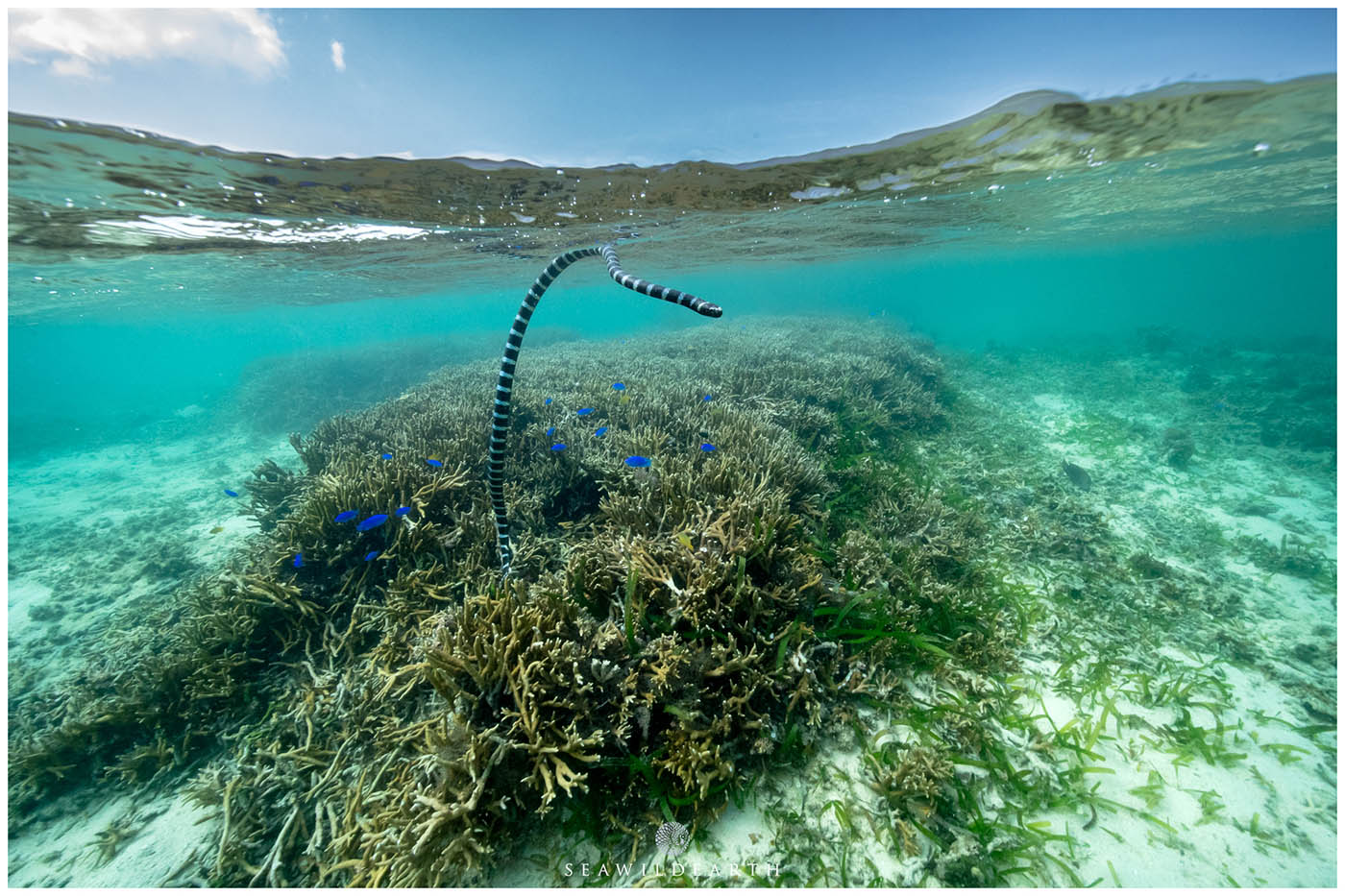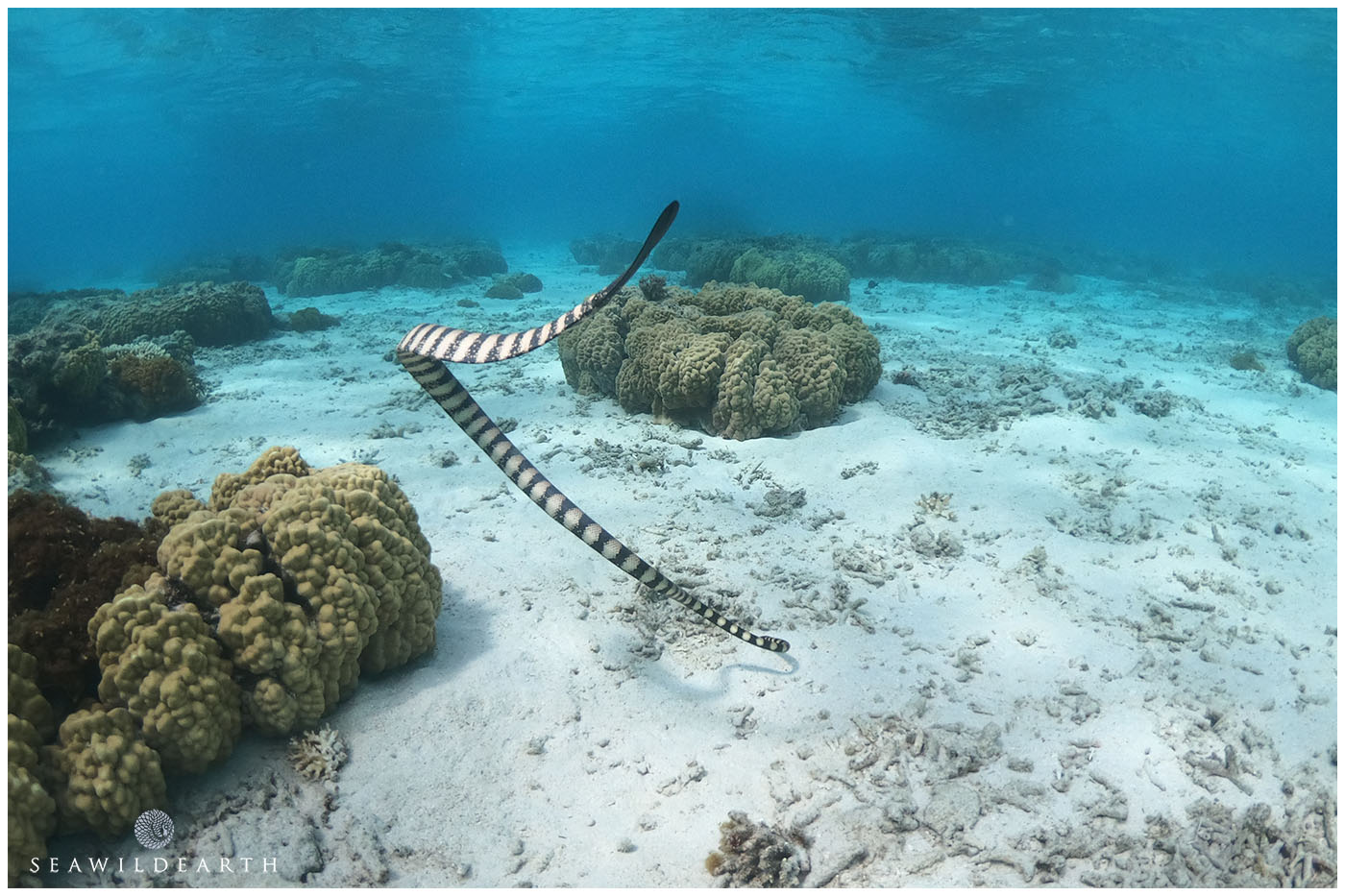Potentially Dangerous Wildlife of Okinawa
The Black Banded Sea Krait is a highly venomous species of Sea Snake that is frequently encountered in the shallow reefs of Okinawa.
Black-Banded Sea Krait, scientifically known as "Laticauda semifasciata," is a type of sea snake found in various regions of the Indo-Pacific Ocean, including parts of Southeast Asia, the Philippines, Japan, and Australia. It is a highly venomous snake and belongs to the family Elapidae, which also includes cobras and coral snakes. Recently photographed during a snorkeling trip with the family I thought I'd post this here to bring some more information to light about this highly inquisitive species.

Here are some key characteristics and features of the Black-Banded Sea Krait:
- Appearance: The Black-Banded Sea Krait is easily recognizable by its striking coloration. It has black bands alternating with white or yellowish bands along its entire body, which makes it resemble a banded pattern. These bands give it its common name. Its head is often black with a yellow or light-colored snout.
- Habitat: These sea snakes are primarily found in shallow coastal waters, coral reefs, and rocky areas. They are highly adapted to an aquatic lifestyle and are rarely seen on land except during the breeding season.
- Behavior: Black-Banded Sea Kraits are known for their unique behavior of periodically coming ashore to lay eggs. They are air-breathing reptiles and need to surface for air. They are excellent swimmers and can often be seen hunting for prey underwater, primarily feeding on fish and eels.
- Venom: Like other sea snakes, the Black-Banded Sea Krait is venomous, possessing potent venom used for immobilizing and digesting their prey. However, they are generally not aggressive toward humans and are not prone to attacking unless they feel threatened or provoked.
- Conservation Status: The conservation status of the Black-Banded Sea Krait varies in different regions, but they are generally not considered endangered. However, like many marine species, they can face threats from habitat destruction, pollution, and accidental bycatch in fishing nets.
- Human Interaction: It's crucial for humans to exercise caution when encountering Black-Banded Sea Kraits, as their venom can be dangerous. Bites are rare but can be serious. It's advisable to observe these snakes from a safe distance in their natural habitat and avoid any attempts to handle or disturb them.
Black-Banded Sea Kraits are fascinating and unique creatures that play a role in the ecological balance of marine ecosystems. They are an example of the incredible adaptations that some reptiles have made to live in the ocean. While they may strike fear into folks at the first sight they should not be seen as malevolent. If you are uncomfortable in their presence the best thing to do is back away from them, maintain visual reference and leave the area. Do not, under any circumstance, try to 'shoo' them away. That could end very badly for you.
!! WARNING !!
During mating seasons, which can vary from location to location throughout their range, this species is incredibly inquisitive. It may swim fast towards swimmers it encounters. This advance can easily be translated as aggressive by those who are ill at ease with any serpentine presence. Again, do not react aggressively towards the snake to scare it away. Overcome your desire to panic and move, calmly, away from the area and exit the water if need be.
The Oceans around Okinawa are home to many species of sea snakes and a close cousin to the Black-Banded Sea Krait is the Yellow-lipped Sea Krait (Laticauda colubrina). Given its appearance it is often confused with the Black-Banded Sea Krait with many people misidentifying it as a Banded Sea Krait. This snake is the most commonly encountered sea snake species in the waters around Okinawa. Note in the image below, taken at Ama Beach in the Kerama Islands, the bands on the Yellow Lipped Sea Krait have greater contrast to the whites as compared to the predominant darker bands of the Black-Banded Sea Krait.

"The oceans are the planet's last great living wilderness, man's only remaining frontier on Earth, and perhaps his last chance to prove himself a rational species.".
John L. Culliney
About the Author
Internationally recognized as a provider of quality mixed media Mark Thorpe is always on the search for captivating content.

Photographer / Cameraman
Mark Thorpe
Emmy Award Winning wildlife cameraman and Internationally published landscape photographer Mark Thorpe has been an adventurer since he could walk! Spending 17yrs as an Underwater Cameraman at the start of his imaging career the highlight of which was being contracted to work with National Geographic. In that role as a field producer and cameraman he's been privy to a mixed bag of hair raising adventures. For some reason he was always selected for projects relating to large toothed marine predators such as Great White and Tiger Sharks, Sperm Whales and Fur Seals. Additionally he has also been active within Southern Africa on terrestrial projects dealing with a wide array of iconic wildlife.
Currently based in Okinawa, Japan he's always on the lookout for his next big adventure. He shares his exploits online with a totally organic social audience in excess of 200,000. Sponsored by a number of photographic industry manufacturers he is constantly scouring the islands for captivating landscape and oceanscape compositions. Videography wise he continues to create short photographic tutorial videos as well as creating content about the diversity of wildlife within Okinawa and the Ryukyu Islands of Southern Japan.
Mark has just created a Patreon channel where he's hoping to raise an audience of supporters who through small monthly shows of appreciation will allow him to concentrate on the creation of a wildlife and landscape imaging themed YouTube Channel. If you feel that is something you'd like to support you can visit his Patreon Channel for more information.
